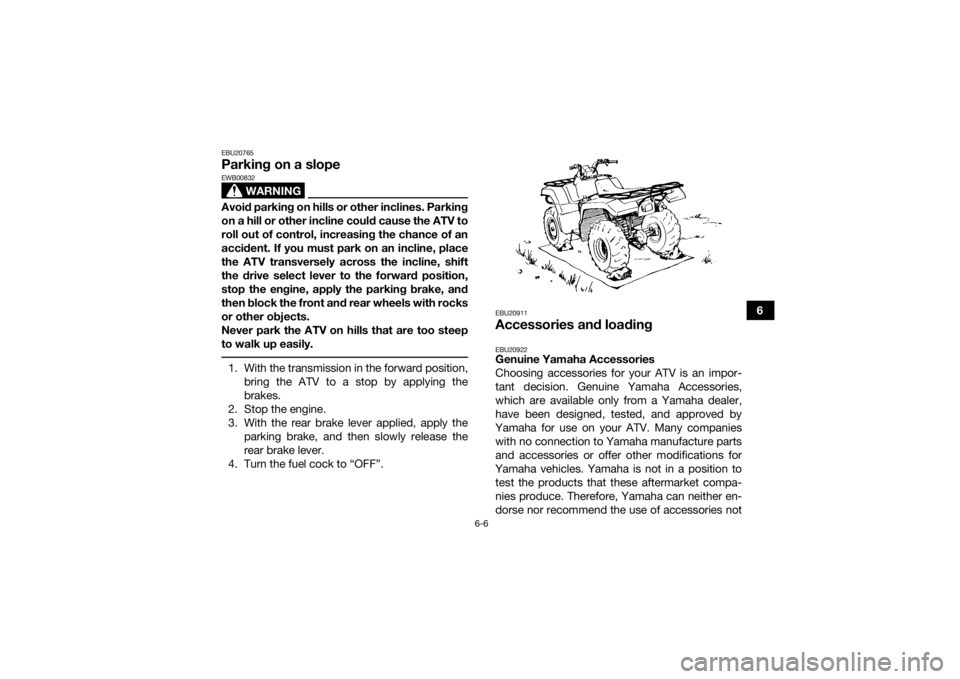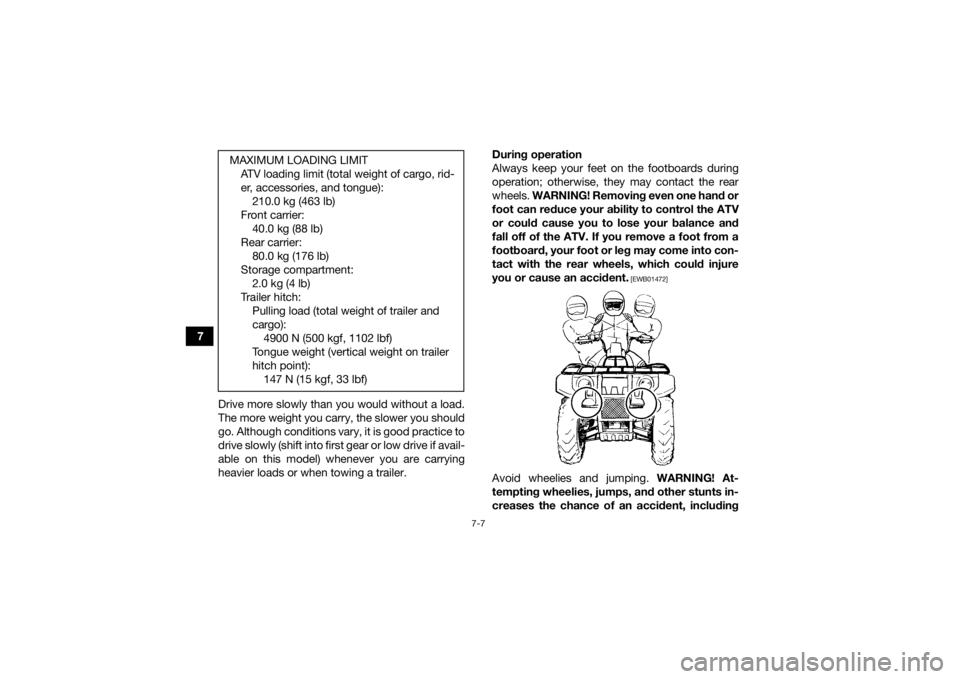2017 YAMAHA GRIZZLY 350 wheel
[x] Cancel search: wheelPage 10 of 140

Checking and lubricating the cables......... 8-35
Checking and lubricating the front and rear brake levers ..................................... 8-35
Checking and lubricating the brake pedal ....................................................... 8-36
Checking the wheel hub bearings............. 8-36
Lubricating the steering shaft ................... 8-37
Battery....................................................... 8-37
Replacing a fuse ....................................... 8-40
Replacing a headlight bulb ....................... 8-42
Adjusting a headlight beam ...................... 8-43
Replacing the tail/brake light bulb ............ 8-44
Removing a wheel ..................................... 8-44
Installing a wheel....................................... 8-44
Troubleshooting ........................................ 8-46
Troubleshooting chart ............................... 8-47
CLEANING AND STORAGE ........................... 9-1 Cleaning ...................................................... 9-1
Storage........................................................ 9-2
SPECIFICATIONS ........................................ 10-1
CONSUMER INFORMATION ....................... 11-1 Identification numbers .............................. 11-1
INDEX ........................................................... 12-1
UB1463E0.book Page 3 Thursday, August 4, 2016 2:12 PM
Page 21 of 140

2-2
2
Never operate at speeds too fast for your skills
or the riding conditions. Always go at a speed
that is proper for the terrain, visibility, operating
conditions, and your experience.
Never attempt wheelies, jumps, or other stunts.
Always inspect your ATV each time you use it to
make sure it is in safe operating condition. Al-
ways follow the inspection and maintenance
procedures and schedules described in this
manual.
Always keep both hands on the handlebars and
both feet on the footboards of the ATV during
operation.
Always go slowly and be extra careful when op-
erating on unfamiliar terrain. Always be alert to
changing terrain conditions when operating the
ATV.
Never operate on excessively rough, slippery or
loose terrain until you have learned and prac-
ticed the skills necessary to control the ATV on
such terrain. Always be especially cautious on
these kinds of terrain.
Always follow proper procedures for turning as
described in this manual. Practice turning at low
speeds before attempting to turn at faster
speeds and never turn at excessive speeds.
Never operate the ATV on hills too steep for the
ATV or for your abilities. Practice on smaller hills
before attempting larger hills.
Always follow proper procedures for climbing
hills as described in this manual. Check the ter-
rain carefully before you start up any hill. Never
climb hills with excessively slippery or loose
surfaces. Shift your weight forward. Never open
the throttle suddenly. Never go over the top of a
hill at high speed.
Always follow proper procedures for going
down hills and for braking on hills as described
in this manual. Check the terrain carefully before
you start down any hill. Shift your weight back-
ward. Never go down a hill at high speed. Avoid
going down a hill at an angle that would cause
the vehicle to lean sharply to one side. Go
straight down the hill where possible.
Always follow proper procedures for crossing
the side of a hill as described in this manual.
Avoid hills with excessively slippery or loose
surfaces. Shift your weight to the uphill side of
the ATV. Never attempt to turn the ATV around
on any hill until you have mastered the turning
UB1463E0.book Page 2 Thursday, August 4, 2016 2:12 PM
Page 24 of 140

2-5
2ungrounded or broken wiring. Visually check
for broken wiring and leaking fuel. Leaking
fuel can be confirmed by the odor of gasoline.
4. Once immediate safety hazards are con- firmed not to exist, you may remove your hel-
met to more closely inspect your vehicle.
Check for external signs of wear, broken
parts, fluid leaks, cracks in the frame, sus-
pension damage, wheel damage, and so on.
Fuel, oil, and coolant usually give off a notice-
able odor.
5. If your vehicle will not restart or if it is unsafe to ride, then turn off all vehicle systems (en-
gine stop switch, main switch, and fuel cock),
and then signal or go for help.
Aftermarket Parts, Accessories, and Modifica-
tions
While you may find aftermarket products similar in
design and quality to genuine Yamaha accesso-
ries, recognize that some aftermarket accessories
or modifications are not suitable because of po-
tential safety hazards to you or others. Installing
aftermarket products or having other modifica-
tions performed to your vehicle that change any of
the vehicle’s design or operation characteristics
can put you and others at greater risk of serious injury or death. You are responsible for injuries re-
lated to changes in the vehicle. Keep the following
guidelines in mind, as well as those provided un-
der “Loading” when mounting accessories.
Never install accessories that would impair the
performance of your ATV. Carefully inspect the
accessory before using it to make sure that it
does not in any way reduce ground clearance,
limit suspension travel, steering travel or control
operation.
Accessories fitted to the ATV can create insta-
bility due to improper weight distribution.
Bulky or large accessories may seriously affect
the stability of the ATV.
Certain accessories can displace the operator
from his or her normal riding position. This im-
proper position limits the freedom of movement
of the operator and may limit control ability,
therefore, such accessories are not recom-
mended.
Use caution when adding electrical accesso-
ries. If electrical accessories exceed the capac-
ity of the ATV’s electrical system, an electric
failure could result, which could cause a dan-
gerous loss of lights or engine power.
UB1463E0.book Page 5 Thursday, August 4, 2016 2:12 PM
Page 45 of 140

5-2
5
Rear brake• Check operation, and correct if necessary.
• Lubricate cables if necessary.
• Check lever and pedal free play, and adjust if necessary. 5-3, 8-26, 8-29
Throttle lever • Make sure that operation is smooth. Lubricate cable and lever
housing if necessary.
• Check lever free play, and adjust if necessary. 5-4, 8-24
Control cables • Make sure that operation is smooth. Lubricate if necessary. 8-35
Wheels and tires • Check wheel condition, and replace if damaged.
• Check tire condition and tread depth. Replace if necessary.
• Check air pressure. Correct if necessary. 5-4
Brake pedal • Make sure that operation is smooth. Lubricate pedal pivoting point
if necessary. 8-36
Brake levers • Make sure that operation is smooth. Lubricate lever pivoting points
if necessary. 8-35
Chassis fasteners • Make sure that all nuts, bolts and screws are properly tightened. 5-6
Instruments, lights and
switches • Check operation, and correct if necessary. 5-6
ITEM ROUTINE PAGE
UB1463E0.book Page 2 Thursday, August 4, 2016 2:12 PM
Page 55 of 140

6-6
6
EBU20765Parking on a slope
WARNING
EWB00832Avoid parking on hills or other inclines. Parking
on a hill or other incline could cause the ATV to
roll out of control, increasing the chance of an
accident. If you must park on an incline, place
the ATV transversely across the incline, shift
the drive select lever to the forward position,
stop the engine, apply the parking brake, and
then block the front and rear wheels with rocks
or other objects.
Never park the ATV on hills that are too steep
to walk up easily. 1. With the transmission in the forward position,bring the ATV to a stop by applying the
brakes.
2. Stop the engine.
3. With the rear brake lever applied, apply the parking brake, and then slowly release the
rear brake lever.
4. Turn the fuel cock to “OFF”.
EBU20911Accessories and loadingEBU20922Genuine Yamaha Accessories
Choosing accessories for your ATV is an impor-
tant decision. Genuine Yamaha Accessories,
which are available only from a Yamaha dealer,
have been designed, tested, and approved by
Yamaha for use on your ATV. Many companies with no connection to Yamaha manufacture parts
and accessories or offer other modifications for
Yamaha vehicles. Yamaha is not in a position to test the products that these aftermarket compa-
nies produce. Therefore, Yamaha can neither en-
dorse nor recommend the use of accessories not
UB1463E0.book Page 6 Thursday, August 4, 2016 2:12 PM
Page 64 of 140

7-7
7Drive more slowly than you would without a load.
The more weight you carry, the slower you should
go. Although conditions vary, it is good practice to
drive slowly (shift into first gear or low drive if avail-
able on this model) whenever you are carrying
heavier loads or when towing a trailer. During operation
Always keep your feet on the footboards during
operation; otherwise, they may contact the rear
wheels.
WARNING! Removing even one hand or
foot can reduce your ability to control the ATV
or could cause you to lose your balance and
fall off of the ATV. If you remove a foot from a
footboard, your foot or leg may come into con-
tact with the rear wheels, which could injure
you or cause an accident.
[EWB01472]
Avoid wheelies and jumping. WARNING! At-
tempting wheelies, jumps, and other stunts in-
creases the chance of an accident, including
MAXIMUM LOADING LIMIT
ATV loading limit (total weight of cargo, rid-
er, accessories, and tongue):210.0 kg (463 lb)
Front carrier: 40.0 kg (88 lb)
Rear carrier: 80.0 kg (176 lb)
Storage compartment: 2.0 kg (4 lb)
Trailer hitch: Pulling load (total weight of trailer and
cargo):4900 N (500 kgf, 1102 lbf)
Tongue weight (vertical weight on trailer
hitch point): 147 N (15 kgf, 33 lbf)
UB1463E0.book Page 7 Thursday, August 4, 2016 2:12 PM
Page 65 of 140
![YAMAHA GRIZZLY 350 2017 Owners Manual 7-8
7
an overturn. Never attempt stunts, such as
wheelies or jumps. Don’t try to show off.
[EWB01482]Modifications and accessories
Never modify this ATV through improper installa-
tion or use of acc YAMAHA GRIZZLY 350 2017 Owners Manual 7-8
7
an overturn. Never attempt stunts, such as
wheelies or jumps. Don’t try to show off.
[EWB01482]Modifications and accessories
Never modify this ATV through improper installa-
tion or use of acc](/manual-img/51/50348/w960_50348-64.png)
7-8
7
an overturn. Never attempt stunts, such as
wheelies or jumps. Don’t try to show off.
[EWB01482]Modifications and accessories
Never modify this ATV through improper installa-
tion or use of accessories or other modification. All
parts and accessories added to this ATV should
be genuine Yamaha or equivalent components
designed for use on this ATV and should be in-
stalled and used according to instructions. If you
have questions, consult an authorized ATV dealer.
WARNING! Operating this ATV with improper modifications may cause changes in handling
which in some situations could lead to an acci-
dent.
[EWB01492]
Exhaust system
WARNING
EWB01502 Dry grass or brush or other combustible ma-
terial accumulated around the engine area
could catch fire. Do not operate, idle, or park
the ATV in dry grass or other dry ground cov-
er. Keep the engine area free of dry grass,
brush, or other combustible material.
Someone touching the exhaust system dur-
ing or after operation could be burned. Do
not touch the hot exhaust system. Do not
park the ATV in a place where others might
be likely to touch it. The muffler and other engine parts become ex-
tremely hot during operation and remain hot after
the engine has stopped. To reduce the risk of fire
during operation or after leaving the ATV, do not
let brush, grass and other materials collect under
the vehicle, near the muffler or exhaust pipe, or
next to other hot parts. Check under the vehicle
after operating in areas where combustible mate-
rials may have collected. Do not idle or park the
vehicle in long dry grass or other dry ground cov-
er.
UB1463E0.book Page 8 Thursday, August 4, 2016 2:12 PM
Page 69 of 140

7-12
7
Select a large, flat, unpaved area to become famil-
iar with your ATV. Make sure that this area is free
of obstacles and other riders. You should practice
control of the throttle, brakes, and turning techni-
ques in this area before trying more difficult ter-
rain.
Set the parking brake and follow the instruction on
page 6-1 to start the engine. Once it has warmed
up you are ready to begin riding your ATV. With
the engine idling, return the starter (choke) to the
closed position and shift the drive select lever into
the forward position, then release the parking
brake. Apply the throttle slowly and smoothly.
The centrifugal clutch will engage and you will
start to accelerate. If the throttle is applied too
abruptly, the front wheels may lift off the ground,
resulting in a loss of directional control. Avoid
higher speeds until you are thoroughly familiar
with the operation of your ATV.
When slowing down or stopping, release the
throttle and apply the brakes smoothly and evenly.
Improper use of the brakes can cause the tires to
lose traction, reducing control and increasing the
possibility of an accident. TURNING YOUR ATV
WARNING
EWB01772Always follow proper procedures for turning as
described in this Owner’s Manual. Practice
turning at low speeds before attempting to turn
at faster speeds. Do not turn at speeds too fast
for your skills or the conditions. ATV could go
out of control, causing a collision or overturn. To achieve maximum traction on unpaved surfac-
es, the two rear wheels turn together at the same
speed. Therefore, unless the wheel on the inside
of the turn is allowed to slip or lose some traction,
the ATV will resist turning. A special turning tech-
nique must be used to allow the ATV to make
turns quickly and easily. It is essential that this skill
be learned first at low speed.
As you approach a curve, slow down and begin to
turn the handlebars in the desired direction. As
you do so, put your weight on the footboard to the
outside of the turn (opposite your desired direc-
tion) and lean your upper body into the turn. Use
the throttle to maintain an even speed through the
turn. This maneuver will let the wheel on the inside
of the turn slip slightly, allowing the ATV to make
the turn properly.
UB1463E0.book Page 12 Thursday, August 4, 2016 2:12 PM